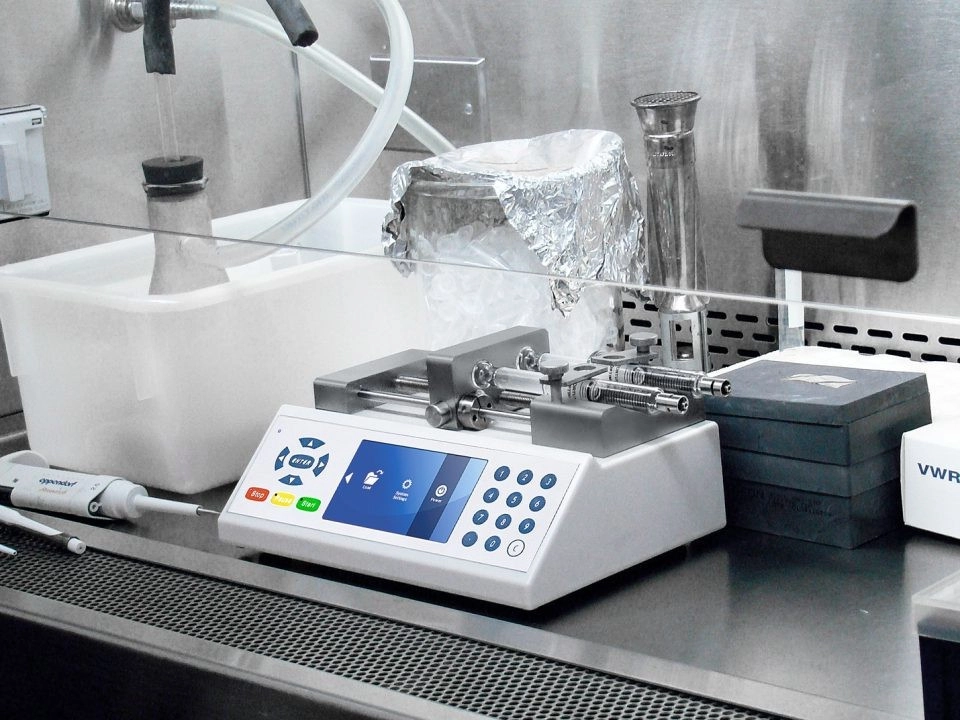
Choosing the Right Syringe for Your Pumping Application
The importance of the proper materials in minimizing contamination and maximizing consistency

Why should you research syringe materials and their compatibility with your intended application?
Did you know that not all syringe types are similar, and the price and general applicability of syringes should not be the lone factors to consider?
When sourcing syringes and syringe pumps, shoppers sometimes go for those with which they are familiar or perhaps those that are least expensive. Syringes come in all shapes and sizes to suit your research needs. However, dimensions and volume are not the only important parameters. Moreover, familiarity and price can be roadblocks to helping you locate the right syringe options for the best possible results. Considerations should include:
- Review of the accuracy and precision that is required for your application
- Evaluation of the materials of the syringe piston, cylinder, and seals to be sure they are compatible with the liquids you plan to pump
- Assessment of durability, which is another factor that impacts consistency and reliability in your pumping applications
Close review of the syringe materials, suitability, and intended applications will set you on a road to success in your research journey.
Identifying your needs in the laboratory
As an initial step in selecting a syringe type, consider your needs and the intended use.
Life science syringe pump applications can include cell injections, drug delivery, microfluidics, analytical techniques such as liquid chromatography and mass spectrometry, and a range of other uses. These applications may have a need for biologically inert or biocompatible materials, as well as requirements to minimize interference and maximize detection sensitivity for downstream processes.
Materials science syringe pump applications may involve a range of organic or inorganic solvents. Liquids with differing viscosities can require metal or glass syringes, while solutions with low or high pH levels can be compatible with plastic or glass syringes and Teflon pistons.
Establish
your volume requirements and the need for accuracy and repeatability
Syringes can range in scale from mL to µL to nL. The volume you plan to pump
should be no less than 1% of the total volume of the syringe for precision
micro-syringes and 10% of the total for plastic syringes, primarily due to
barrel flex and soft plungers. A syringe that is too large can have
consequences stemming from measurement error and variability.
Consider
the flow rate and operational pressure requirements
A
flow rate that is too high may result in sample shearing, which may affect the
integrity of solutes of biological molecules in the solution. A more viscous
liquid will command higher operation pressures, and a balance must be met
between pressure and flow rate. Some flow rates will require the use of all
metal syringes.
Also
consider the durability and maintenance
Chances are you will have multiple samples and more than a single procedure or
experiment to run. Evaluate the ease of washing and restoring the syringes for
repeated use. This may be necessary to minimize carryover, contamination, and
potential variability between runs. This is especially relevant when using
caustic or reactive chemicals in your samples. Be prepared to have a sonicator
to clean syringes immediately after use.
Identifying syringe compatibility with the intended applications
The next step is to evaluate the syringe materials to determine compatibility with your applications.
The components of a syringe include the cylinder, the piston (or plunger), and the seals. Commonly used cylinder materials include glass, plastic (e.g. polypropylene, PTFE), or stainless steel. Plastic is generally the most cost-effective and lightweight, and can be single-use or disposable. Stainless steel is the most expensive and can typically handle high-pressure applications. Glass is chemically inert and compatible with most biological samples.
Caution
should be used when determining the type of syringe cylinder
Plastic
cylinders can suffer degradation by organic solvents and acidic solutions. These
and other liquids can also cause potential metal leaching from stainless steel.
Glass exhibits good chemical resistance and will not significantly degrade over
time due to the chemical nature of the solutions.
The
seals play a key role in preventing leakage and maintaining accuracy
Common
seal materials include silicone, PTFE, and rubber. It’s important to consider
the chemical compatibility, temperature resistance, and pressure limits. Any compromise
or breakdown can lead to issues, including contamination of the sample solution
or ejection from the back of the syringe, which is a safety hazard.
The
piston must function under pressure and be compatible with the intended
solutions
The
piston materials are typically plastic, Teflon, ceramic, or glass, depending on
the type of cylinder and pressure needs. A combination of strength and
durability must be identified to ensure the syringe will perform at the
pressures needed without incurring contamination.
Additional
concerns
Take
note that polypropylene can absorb solvents and result in swelling issues that
affect performance and accuracy. Also, be aware that the use of silicone oil,
which is used to lubricate the piston, may lead to contamination.
Summary
It’s paramount to consider the application(s) and the factors mentioned above.
For many applications, glass is the best option. Chemical resistance, accurate volume measurements, and minimal reactivity with seals and other materials are major strengths. For small-volume applications, gas-tight glass syringes forego the need for seals, although they still may incorporate a Teflon plunger. Ground glass syringes remove Teflon from the equation and provide a superior fit for a wide array of applications.
In the end, sufficient scrutiny should be placed in selecting the right syringe. After all, the integrity of your resource-intensive downstream applications depends on this upstream product research.
This editorial is published in partnership with Chemyx: https://chemyx.com/
Please review the Chemyx Syringe Library for more information: https://chemyx.com/support/knowledge-base/syringe-library/










